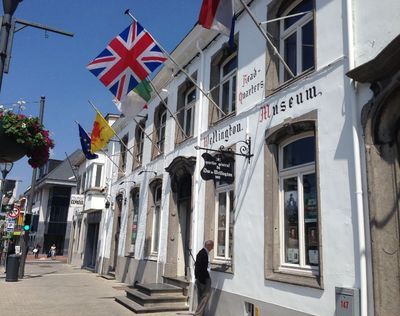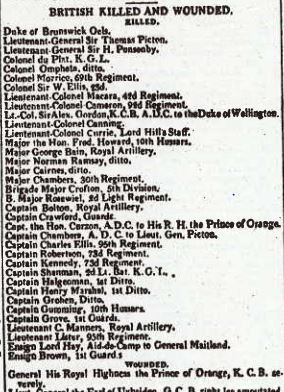Wandering through Waterloo
By ADRIAN TAHOURDIN
The battlefield at Waterloo, 18 kilometres south of Brussels, is flanked by the N5 motorway heading south from the Belgian capital to Charleroi. It���s also about 4 kilometres south of Waterloo itself (no more than a village in 1815, most of whose 1,800 inhabitants fled in the hours leading up to the epochal event). June 18 was a Sunday (no rest for the military then) and those attending church services in Brussels were, it is reckoned not much after 11 am, made anxious by the sound of cannon fire.
Of course you don���t have to be a military historian to be fascinated by Waterloo. Or a historian tout court. Granted it was the last major military engagement of the European pre-industrial age. But Waterloo seems to transcend history. It is, in the French historian���s term, one of the ���great sites of memory��� of modern Europe.
And that site was to contain, on June 18, a mere two days after ferocious engagements at Ligny and Quatre-Bras, upwards of 200,000 soldiers, 60,000 horses and 537 artillery pieces, in undulating fields of rye, lined with ridges, punctuated by woods and copses, and dotted with the odd farm building: Hougoumont, La Haye Sainte.
A couple of hundred metres to the left of the motorway is the brand new underground Waterloo Memorial (it opened at the end of May), a stunning interactive museum full of lifelike exhibits, screen reproductions of paintings from the era, and a great deal more. The visit culminates in an extremely effective fifteen-minute film of the battle, seen through 3-D glasses.
Exiting into the light, the visitor is drawn to the handsome nearby rotunda, housing the vast panorama, 110 metres in circumference, of the battle by the Parisian artist Louis-Jules Dumoulin, which he started in 1912. It���s showing its age a little, but has an undeniable grandeur. From there, it���s up the 226 steps to the Butte du Lion, or Lion���s Mound, raised to mark the spot where the Prince William of Orange, later King William II of the Netherlands, was wounded. (���They have ruined my battlefield���, Wellington complained.) The platform at the foot of the bronze lion offers a panoramic view of the site; it must be said that ��� as expected and perhaps appropriately ��� there is not a great deal to see: undulating fields; still-standing Hougoumont, where Napoleon launched a furious assault on British troops. But it���s still an evocative sight.
Wellington stayed in Waterloo on the nights of June 17 and 18, in a pleasant inn that now houses the Waterloo Museum. According to two attendants I spoke to, very few French people come to the museum. It can���t be too painful still, after 200 years? Or is the memory of Napoleon tinged with embarrassment at the carnage he wrought across Europe? Among the exhibits are some brutal-looking surgical instruments and the artificial leg worn by the British commander Lord Uxbridge (his real leg is buried in the garden at the back, under a memorial plaque): Uxbridge is said to have exclaimed to Wellington, ���By God, sir, I���ve lost my leg!���, to which the Duke replied: ���By God, sir, so you have!���
���Nothing, except a battle lost, can be half so melancholy as a battle won���, said Wellington.
The Times of June 22 (below) published the Official Bulletin: ���The Duke of Wellington���s Dispatch, dated Waterloo, the 19th of June, states, that on the preceding day Buonaparte attacked, with his whole force, the British line, supported by a corps of Prussians: which attack, after a long and sanguinary conflict, terminated in the complete Overthrow of the Enemy���s Army, with the loss of ONE HUNDRED and FIFTY PIECES of CANNON and TWO EAGLES. During the night, the Prussians under Marshal BLUCHER, who joined in the pursuit of the enemy, captured SIXTY GUNS, and a large part of BUONAPARTE���s BAGGAGE. The Allied Armies continued to pursue the enemy. Two French Generals were taken.��� Wellington later admitted that it had been the ���nearest run thing you ever saw in your life���.
The Waterloo site is off-limits from the 17th to the 21st, as a re-enactment of the battle will be taking place. That should be quite a spectacle.
Peter Stothard's Blog
- Peter Stothard's profile
- 30 followers







